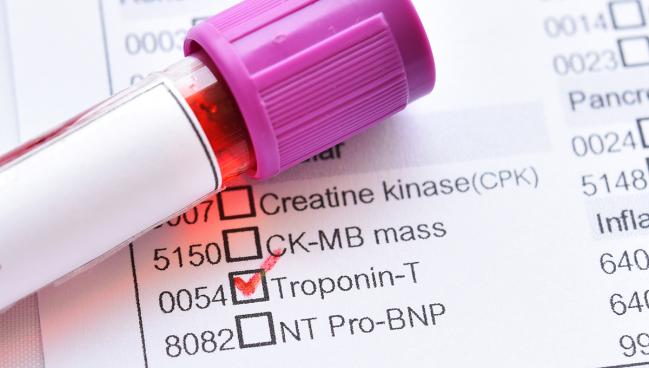High-Sensitivity Troponin Assays Not All the Same, APACE Data Confirm
The ability to diagnose MI was better with troponin I, but T better predicted mortality. Both tests have strengths, researchers say.

When used to evaluate suspected NSTEMI among patients who present to the emergency department (ED), high-sensitivity cardiac troponin T (hs-cTnT) and troponin I (hs-cTnI) diverge for both diagnosis and prognosis, according to a secondary analysis of the APACE study.
The results, published Monday in the Journal of the American College of Cardiology, show that hs-cTnI had better diagnostic accuracy than hs-cTnT for myocardial infarction, whereas hs-cTnT had higher prognostic accuracy for future risk of all-cause and CV death.
“These findings are of interest to clinicians because both assays are currently considered equivalent in both indications,” Luca Koechlin, MD (University of Basel, Switzerland, and GREAT Network, Rome, Italy), and colleagues write in their brief report.
While additional research is needed to test the possibility that combined use of the two tests could offer clinical benefits, “it is reassuring for clinicians to know that both hs-cTnT and hs-cTnI perform exceptionally well for the early diagnosis of myocardial infarction when applied within a triage algorithm, such as the European Society of Cardiology 0/1-hour algorithm,” Koechlin told TCTMD via email. “Both assays provide high safety for ruling out myocardial infarction and excellent accuracy for ruling it in.”
Currently, around half of hospitals use troponin T and half troponin I, he added, with the choice most often made at an institutional level in consultation with clinicians.
Fred S. Apple, PhD (Hennepin Healthcare/Hennepin County Medical Center and the University of Minnesota, Minneapolis), commenting for TCTMD, expressed reservations about the analysis. It’s unclear from the paper when these patients were enrolled in APACE, which is ongoing, he pointed out, or which assays were used and how long testing occurred after symptom onset.
Altogether, these factors mean that the data are hard to interpret, said Apple. “This article doesn’t show anything convincingly new between high-sensitivity troponin I and high-sensitivity troponin T.” To truly know if there is a difference, more details from the dataset are required, he added.
Troponin T vs I
For the study, Koechlin et al excluded patients with STEMI, an unclear diagnosis despite having at least one elevated concentration of hs-cTnT/I, and missing troponin measurements. Their dataset included 7,614 patients (median age 61 years; 34% women), of whom 18.3% had MI when using hs-cTnT and 17.3% when using hs-cTnI.
The researchers compared both tests against two independent central adjudications, Koechlin noted. “This approach minimizes potential bias that could arise when the adjudicated diagnosis is based on either hs-cTnT or hs-cTnI.”
When core-lab adjudication was based on hs-cTnT, the hs-cTnI and hs-cTnT assays were equally able to diagnose MI: the area under the curve (AUC) was 0.93 for each. Yet when adjudicated based on hs-cTnI, the hs-cTnI had better diagnostic accuracy (AUC 0.95 vs 0.93 with hs-cTnT; P < 0.001). Similar results were seen in an external validation cohort derived from the High-STEACS study.
For prognosis, however, hs-cTnT was better at predicting all-cause and CV death from around 90 to 1,800 days. At 90 days, for instance, the AUCs for all-cause death were 0.82 with hs-cTnT and 0.79 with hs-cTnI (P < 0.001), and for CV death, they were 0.85 and 0.83, respectively (P = 0.008). Again these findings were confirmed in the validation cohort.
It’s not yet fully known what’s driving the discrepant performance between the two tests, the authors note. “Their underlying pathophysiological differences remain speculative. The faster release of cTnI vs cTnT from necrotic cardiac tissue, the higher ratio of hs-cTnI/hs-cTnT seen in myocardial ischemia inducing substantial cardiomyocyte necrosis, and the stronger association of hs-cTnT with renal function may play a role.”
Given the tradeoffs between the tests, both still remain useful for clinicians, the researchers say. “Because ‘false-positive’ values for hs-cTn carry a high risk for patient morbidity, and the fact that their causes often differ between hs-cTnT and hs-cTnI, the combined clinical use of these assays should be investigated in future studies,” they add.
Koechlin, in his email to TCTMD, said future studies should explore whether there are “specific clinical scenarios in which one assay may be superior to the other. Additionally, a deeper understanding of the pathophysiological mechanisms underlying these differences is needed to guide clinical decision-making.”
Caitlin E. Cox is News Editor of TCTMD and Associate Director, Editorial Content at the Cardiovascular Research Foundation. She produces the…
Read Full BioSources
Koechlin L, Boeddinghaus J, Doudesis D, et al. Diagnostic and prognostic performance of high-sensitivity cardiac troponin T vs I. J Am Coll Cardiol. 2025;85:381-385.
Disclosures
- The APACE study was supported by research grants from the Swiss National Science Foundation, the Swiss Heart Foundation, the KTI, the University Hospital Basel, the University of Basel, Abbott, Beckman Coulter, Brahms, Idorsia, LSI Medience Corporation, Ortho Clinical Diagnostics, Quidel, Roche, Siemens, Singulex, and SpinChip Diagnostics.
- Koechlin reports receiving a research grant from the Swiss Heart Foundation, the University of Basel, the Swiss Academy of Medical Sciences and the Gottfried and Julia Bangerter-Rhyner Foundation, as well as the “Freiwillige Akademische Gesellschaft Basel” plus speaker honoraria from Polymedco, Dr Risch, Roche Diagnostics, Siemens, and Abbott outside the submitted work and paid to the institution.
- Apple reports serving as a principal investigator for several trials of cardiac troponin over the last 5 years, nonsalaried and through grants to his institution. He also has advised the major manufacturers of troponin assays.





Comments